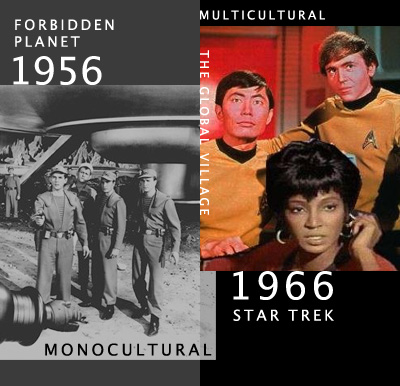How Star Trek Culturally Prototyped the 21st Century

I would be a liar if I said that I spent the past day thinking of about anything but the inauguration of President Barack Obama. One one level I was just overjoyed to hear Obama publicly re-embrace the ideas of science and ecology, which in a way strikes me as sad as being something that “we have to return to” in the first place. And of course the two central issues at hand today are the economy (or rather the lack there of) and ongoing asymmetrical warfare — yet underneath all of that chaos was a very positive echo of the civil rights struggle of the 1960s. And in a sense part of the triumph of that struggle was an indirect result of a few bold visionaries who embraced the then very odd notion of the world growing smaller was a damn good thing.
My journey started a few days ago with the recent passing away of Patrick McGoohan. Thanks to looking at those old episodes of The Prisoner I found myself revisiting the larger idea of the global village which was first popularized by Marshall McLuhan in 1962. To make a long story short the telecommunication satellites of that era became the first steps to breaking down national boundaries in real time — in fact you could say that it was the cultural forerunner of the internet today (and in fact the internet starts with ARPANET in the early 70s at almost the same time).
During the same era we as humans started to take our first steps into outer space and as a result we started to look back at Earth as a single planet instead of a traditional school room globe with national boundaries drawn all over it. The credit for that vision goes to Stewart Brand who campaigned in 1966 to have NASA take a photo of the earth (which they did from Apollo 17 in 1972).

And this brings me back to one of my personal favorite subjects: Star Trek and to a broader extent the science fiction and futurism of from the 1960s. Now if you go back just a few years earlier to 1956 and look at the film Forbidden Planet it represents a very monocultural view of the future — in fact the crew of the C-57D starship could have been identical to an Elizabethan naval vessel from the 1600s. While the film looks good the cultural setup of it feels like its trapped in the 50s.
But then just ten years later with Star Trek we see an international and multicultural crew — and to me this was a direct result of both the civil rights struggle and the world itself becoming a smaller place. And this shift didn’t happen by accident: In the case of Star Trek it was because Gene Roddenberry stuck to his vision of an inclusive future even if it put his show at risk:
One of my favorite Alan Kay quotes is “the best way to predict the future is to invent it” and while techies embrace this notion as their own, in a wider sense creative people do the same thing when they come up with a positive larger vision of society. In many ways we owe part of this particular moment of time to folks like Gene Roddenberry, Marshall McLuhan and Stewart Brand to prototyped their vision of a future society in the books and yes even in a sci fi television show from the 60s.














